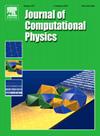A simple tool for the optimization of 1D phononic and photonic bandgap filters
IF 3.8
2区 物理与天体物理
Q2 COMPUTER SCIENCE, INTERDISCIPLINARY APPLICATIONS
引用次数: 0
Abstract
We develop an effective computational tool for simulating the scattering of one-dimensional (1D) waves by a composite layer architected in an otherwise homogeneous medium. The layer is designed as the union of segments cut from various mother periodic media, which allows us to describe the wavefield in each segment in terms of the “left” and “right” (propagating or evanescent) Bloch waves. For a given periodic medium and frequency of oscillations, the latter are computed by solving the quadratic eigenvalue problem (QEP) which seeks the (real- or complex-valued) wavenumber – and affiliated eigenstate – of a Bloch wave. In this way the scattering problem is reduced to a low-dimensional algebraic problem, solved via the transfer matrix approach, that seeks the amplitudes of the featured Bloch waves (two per segment), amplitude of the reflected wave, and that of the transmitted wave. Such an approach inherently caters for an optimal filter (e.g. rainbow trap) design as it enables rapid exploration of the design space with respect to segment (i) permutations (with or without repetition), (ii) cut lengths, and (iii) cut offsets relative to the mother periodic media. Specifically, under (i)–(iii) the Bloch eigenstates remain invariant, so that only the transfer matrices need to be recomputed. The reduced order model is found to be in excellent agreement with numerical simulations. Example simulations demonstrate 40x computational speedup when optimizing a 1D filter for minimum transmission via a genetic algorithm (GA) approach that entails trial configurations. Relative to the classical rainbow trap design where the unit cells of the mother periodic media are arranged in a “linear” fashion according to their dispersive characteristics, the GA-optimized (rearranged) configuration yields a 40% reduction in filter transmissibility over the target frequency range, for the same filter thickness.
求助全文
约1分钟内获得全文
求助全文
来源期刊

Journal of Computational Physics
物理-计算机:跨学科应用
CiteScore
7.60
自引率
14.60%
发文量
763
审稿时长
5.8 months
期刊介绍:
Journal of Computational Physics thoroughly treats the computational aspects of physical problems, presenting techniques for the numerical solution of mathematical equations arising in all areas of physics. The journal seeks to emphasize methods that cross disciplinary boundaries.
The Journal of Computational Physics also publishes short notes of 4 pages or less (including figures, tables, and references but excluding title pages). Letters to the Editor commenting on articles already published in this Journal will also be considered. Neither notes nor letters should have an abstract.
 求助内容:
求助内容: 应助结果提醒方式:
应助结果提醒方式:


